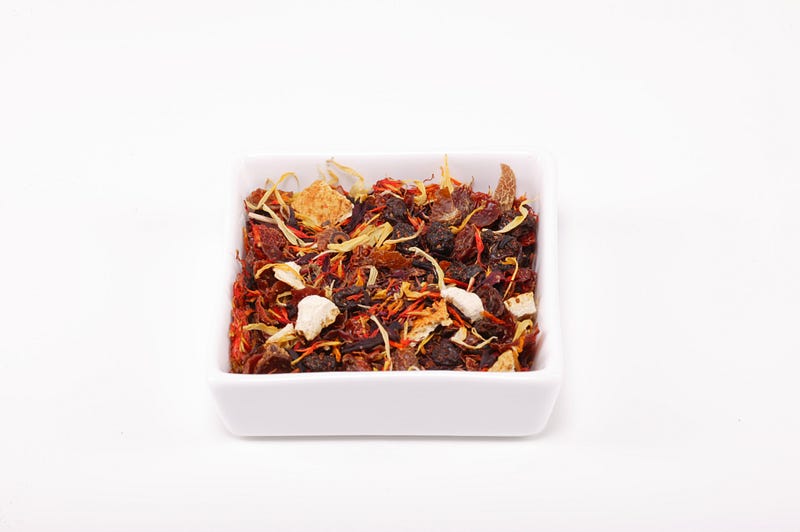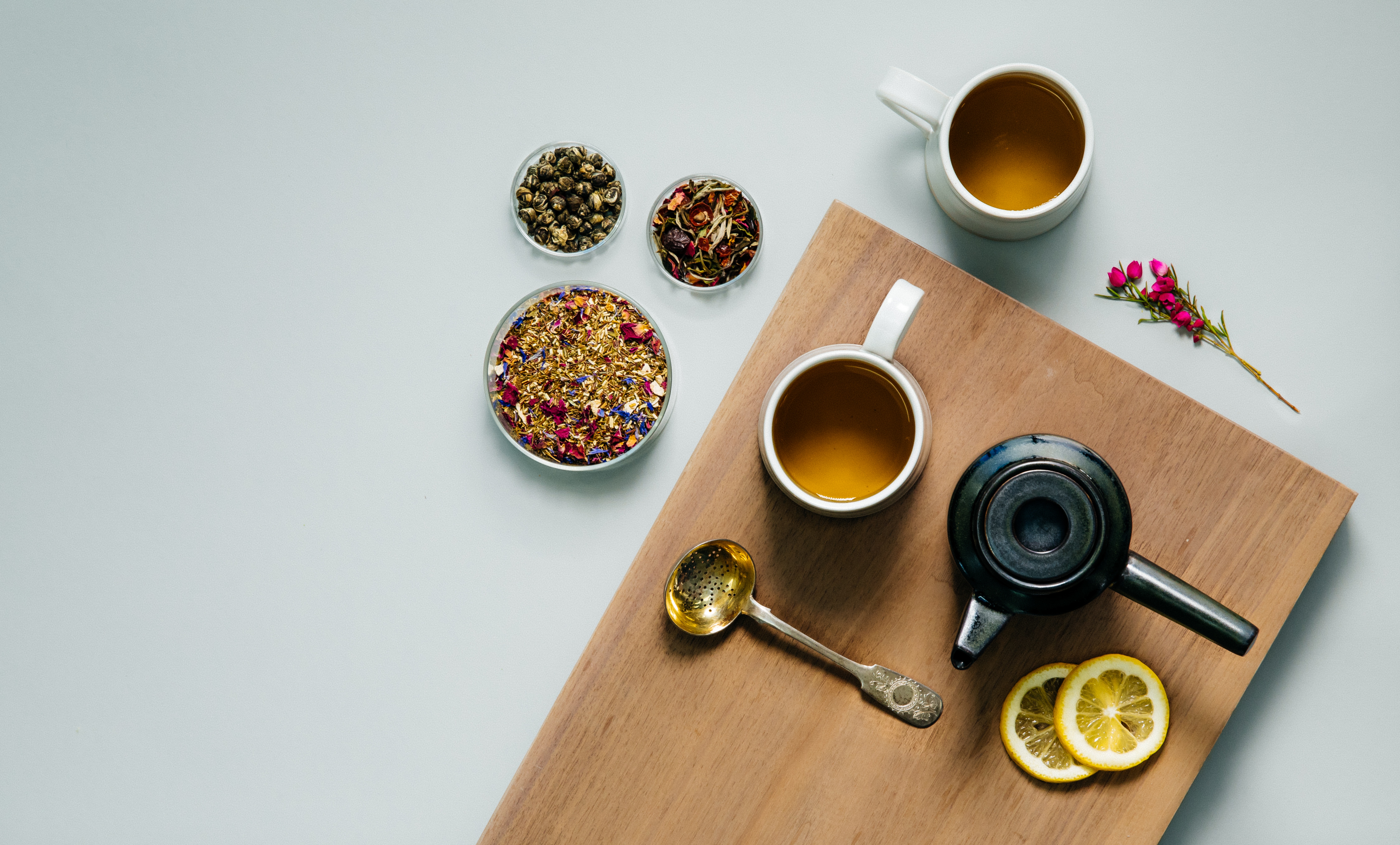Herbal teas are becoming more and more important as the growth of herbs have gained in popularity. According to the American Botanical Council, sales of herbal teas have grown by 19% over the last few years. Tea suppliers nationwide are looking to capitalize on this trend by producing tasty herbal blends. Art of Tea has been producing herbal teas for many years and is poised to help our customers capitalize on this trend.

The term “herbal tea” is more of a colloquialism today, to mean, plant material steeped in hot water like “real” tea (Camellia sinensis). Herbal teas, for the most part, do not contain any Camellia sinensis tea. This category of tea, is sometimes referred to as tisanes or herbal infusions, so as not to confuse consumers. Like tea, these infusions can be served hot or iced.
Wikipedia states, “Tisane or herbal tea is any non-caffeinated beverage made from the infusion or decoction of herbs, spices, or other plant material in hot water.” However, this is not totally accurate. For decades, tea professionals have sworn that herbals are caffeine free. But, in the last few years, a group of caffeinated herbals have gained market share, these include the herbals yerba mate, guayusa, and yaupon.
Nearly every part of a plant can be used for herbal teas:
- Leaves: peppermint, spearmint, rooibos
- Fruits: rosehips, apple
- Petals: jasmine, safflower, hibiscus, chrysanthemum
- Herbs: lemon verbena, basil
- Bark: cinnamon, willow
- Seeds: anise, fennel, cardamom
- Pollen: chamomile flower pollen
- Grass: lemon grass, oat straw
- Peels: orange, lemon
- Nuts: almonds, cola, nutmeg
- Roots: ginger, licorice
We use several different herbal ingredients in our herbal teas. What follows is an introduction to a few of them.
CHAMOMILE
Latin Name: Matricaria chamomilla, M. recutita
Origin: Egypt, Germany, Poland, Croatia, Argentina, Chile
Description: The plant is an annual plant, which is often sought after for its soothing and calming affects. Individuals allergic to ragweed may also be allergic to chamomile due to cross-reactivity.
Part Used: Flower, pollen, stalk
Color: Golden
Odor: Honey-like, Flowery, Sweet, apple-like
Taste: Sweet, Mild, honey-like, flowery, slightly bitter, apple-like
CINNAMON
Latin Name: Cinnamomum verum, C. burmannii, C. loureiroi, C. cassia
Origin: Sri Lanka, Indonesia, Vietnam, China
Description: A spice obtained from the inner bark of several trees from the genus. While C. verum is often considered “true cinnamon,” most of what is sold commercially comes from the species C. lourieroi, referred to as Saigon cinnamon, this species is most often used in blends, due to its sweetness.
Part Used: Bark
Color: Pale Brown
Odor: Spicy, sweet
Taste: Cinnamony-spicy, hot & sweet
GINGER ROOT
Latin Name: Zingiber officinale
Origin: South Asia, East Africa, Caribbean
Description: The rhizome (a subterranean stem) of the plant. The rhizome is gathered when the stalk withers. It is immediately scalded or washed, then scraped to kill it and prevent sprouting. It is a perennial reed-like plant with annual leafy stems about 3–4 feet tall. Because of its aesthetic appeal, ginger is often used as landscaping around subtropical homes.
Part Used: Root
Color: Pale Yellow
Odor: Spicy
Taste: Fragrant, spicy-hot
GUAYUSA
Latin Name: Ilex guayusa
Origin: Ecuador, Peru, Colombia
Description: An evergreen tree found in the Amazon Rainforest. Guayusa is part of the holly genus and its leaves contain caffeine. Traditionally consumed by the local Ecuadorian Kichwa people for its stimulating effects, guayusa is finding popularity with Hollywood celebrities like Channing Tatum and Leonardo DiCaprio. Called the first super-leaf because it is packed with a lot of antioxidants.
Part Used: Leaf
Color: Golden Brown
Odor: Earthy, Herbaceous, Toasty
Taste: Earthy, Woody, Touch of Sweetness
HIBISCUS
Latin Name: Hibiscus sabdariffa
Origin: China, Egypt, Sudan, Nigeria
Description: The plant is an annual shrub that grows to about 15 feet tall and has lobed leaves. The flowers have a five-lobed, red, fleshy calyx that is about 1 inch long. Hibiscus is often intercropped with peanuts, and though it is extremely rare, it is possible to get peanut shells mixed in with the hibiscus.
Part Used: Flower
Color: Deep burgundy-red
Odor: Faint, tart, fruity
Taste: Sour, tart, fruity, berry-like
HONEYBUSH
Latin Name: Cyclopia (with various species)
Origin: South Africa
Description: Discovered in the 18th Century, the honeybush shrub owes its name to its appearance. The blossoms are bright yellow and smell like honey, whereas the leaves are somewhat rough. It is called vegetable bush by the locals, due to its pod-shaped fruits and knobby roots. Has many similarities with rooibos.
Part Used: Leaves
Color: Golden
Odor: Sweet, earthy
Taste: Sweet and Aromatic with gentle roasty flavor
LEMON GRASS
Latin Name: Andropogon citratus
Origin: Egypt, Thailand
Description: This plant is a sweetly scented grass, growing up to five feet tall. Its bulbous stems become leaf blades that are pointed and long. When sliced fresh, the stalks show concentric, sheathed leaves. The lower 4–6 inches of the leek-like stalk has the most succulent flavor. The upper portion of the leaf has a fold along its center ridge.
Part Used: Stalk (lower 4–6 inches)
Color: Light yellowish green to mint green
Odor: Aromatic, lemon-like, sweet
Taste: Lemon-like
LEMON MYRTLE
Latin Name: Backhousia cotriodora
Origin: Australia, Malaysia
Description: Also known as lemon scented ironwood and sweet verbena tree. It can reach up to 66 feet, but is often smaller. The flowers are creamy-white clusters at the ends of the branches from summer through autumn, after petal fall, the calyx is persistent. The majority of commercial lemon myrtle is grown in Queensland and the north coast of New South Wales, Australia.
Part Used: Leaf
Color: Yellowish
Odor: Lemon
Taste: Sweet lemon
LICORICE ROOT
Latin Name: Glycyrrhiza glabra
Origin: Afghanistan, China, Pakistan, Iraq, Azerbaijan, Uzbekistan, Turkmenistan, Turkey
Description: This licorice plant is a legume and is NOT botanically related to anise, star anise, or fennel, which are sources of similar flavors. It is an herbaceous perennial growing to about 1 meter tall with pinnate leaves. The flowers are long, purple to pale whitish-blue, produced in a loose inflorescence.
Part Used: Root
Color: Pale Yellow
Odor: Sweet Anise-like
Taste: Sweet Anise-like
Next week we will be sharing the rest of the the herbal ingredients used at Art of Tea!
Art of Tea is an award winning purveyor of specialty and organic teas, based in Los Angeles, CA.
If you found this article helpful, please share it with coworkers, colleagues, and fellow lovers of tea.

